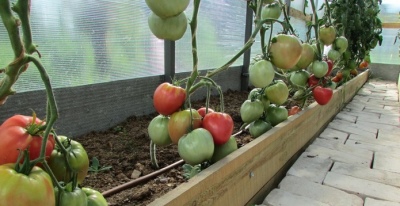
- Category: grade
- Growth type: indeterminate
- Appointment: fresh consumption, for juice, for ketchup and tomato paste
- Ripening period: mid-season
- Growing conditions: for greenhouses
- Bush size: tall
- Bush height, cm: up to 250
- Ripe fruit color: pink (raspberry)
- Fruit shape: heart-shaped
- Fruit weight, g: up to 800
The Giant tomato of the Moscow region is one of the most preferred garden plants in our country. However, it also needs its own special approach, there are a number of unique nuances. Only gardeners who have studied all this can guarantee complete success.
Description of the variety
The giant of the Moscow Region fully justifies its name. This culture grows up to 2.5 m.Therefore, it is necessary to equip rather high greenhouses for it or to allocate open areas. But greenhouse cultivation is more preferable, and it is precisely this that is recommended according to the official culture card.
The main qualities of the fruit
Basically, the berries of the Giant of the Moscow Region are pink or crimson. For them, as well as for bushes, large size is typical. Weight can reach 0.8 kg. However, this figure usually ranges from 0.4 to 0.6 kg. The shape of the fruit is like a heart.
Taste characteristics
Sweet taste is typical for the Giant of the Moscow Region. Its flesh is fleshy, which is highly appreciated by all consumers. According to some unofficial sources, it is often not sweet, but sweetish taste. It supposedly also contains sour and fruity notes.
Ripening and fruiting
The giant of the Moscow region is considered a mid-season tomato. It takes some time to hatch and form green shoots. If this happened, and then further care was provided, then the first harvest can be expected in 112-125 days. Fruit harvesting can take up to the onset of frost.
Yield
Experts have already fully confirmed the fruitful nature of this variety. Important: for some farmers, a clear disadvantage will be the impossibility of canning whole fruits. From 1 sq. m. vegetable garden is harvested from 8 to 12 kg of berries. In this case, of course, the weather is of great importance. But the efforts of the gardeners themselves are also hardly worth discounting.
The timing of planting seedlings and planting in the ground
The seedlings should harden within 50-60 days. A few days before this, its shoots will develop. Therefore, between sowing seeds and transferring clods into open ground or a greenhouse, usually 60-70 days pass. They are guided in each case by the readiness of specific plants, because it may not be the same even among neighboring farmers.

Growing tomato seedlings is an extremely important process, because it largely depends on whether the gardener will be able to harvest at all. All aspects must be taken into account, from seedbed preparation to planting in the ground.
Landing scheme
The gap between the bushes can be from 0.5 to 0.6 m. Within these limits, gardeners are free to vary the arrangement of tomatoes at their discretion. But going beyond it is categorically unacceptable.

Growing and care
There is nothing extraordinary here. You will definitely need to tie up and shape the bushes. But these requirements are quite obvious and predictable for such a tall plant. Forming is carried out in 1 or 2 stems of your choice. 14 days after planting in the ground, you will need to feed with a mixture based on phosphorus and potassium.
At the time of flowering, a mullein diluted 10 times is used. Potassium sulfate should be added to it in order to achieve maximum effect. At the time of the formation of the ovaries, the first assistant to the gardener will be an aqueous solution of wood ash. When tomatoes ripen, they need to be helped with the help of humate and superphosphate solutions.
The harvest harvested ahead of schedule can be left to ripen. This will not affect taste and other parameters. Irrigation is recommended before sunset to prevent burns. For 1 bush, no more than 12 liters of water should be poured per day. These measures, as well as systematic weeding, practically eliminate the problem.




A plant needs different micronutrients at each stage of growth. All fertilizers can be divided into two groups: mineral and organic. Folk remedies are often used: iodine, yeast, bird droppings, eggshells.
It is important to observe the rate and period of feeding. This also applies to folk remedies and organic fertilizers.


Review overview
The Gigant variety of the Moscow Region enjoys a good reputation. It is appreciated for the decent characteristics of the fruit: they are both large and tasty at the same time. Fruiting takes a long time and pleases with its stability. Everyone who has tried to grow this variety at least once intends to continue working on it in the future. Even in a damp and cold year, attentive gardeners can do well.

























































































